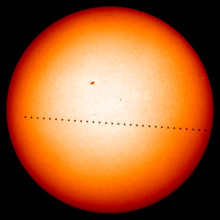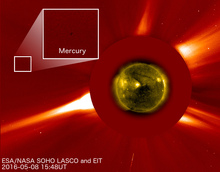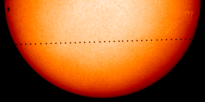2016 Mercury Transit (May 9, 2016)

2016 Mercury Transit (EIT) Movie (.mp4)

2016 Mercury Transit (MDI) Movie (.mp4)

Mercury in SOHO/LASCO C2 occulting the bright background solar corona.
2016 Mercury transit images and movies (9 May, 09:04 - 16:51 UT)
SOHO/EIT images and movies from IAS
SDO movies (transit times approximately 2 hours after SOHO's): mercurytransit.gsfc.nasa.gov
SOHO/LASCO C3 movie of Mercury approaching the Sun:
Large (70 MB),
Small (7.5 MB)
Mercury is the small bright dot approaching the Sun from the left. The bright object appearing at the
right at the end of the sequence is Venus, which is too bright for the very sensitive optics and camera designed to image the Sun's corona.
It happens less than once a decade -- and the next chance to see it is on 9 May 2016. On that day skywatchers throughout most of the world can catch a glimpse of Mercury as it passes between Earth and the Sun in a rare astronomical event known as a planetary transit. Mercury will appear as a tiny black dot as it glides in front of the Sun's blazing disk over a period of seven and a half hours.
Although Mercury zooms around the sun every 88 days, the Earth, Sun and Mercury rarely align. And because Mercury orbits in a plane that is tilted from Earth's orbit, it usually moves above or below our line of sight to the Sun. As a result, Mercury transits occur only about 13 times a century.
Three solar missions - SOHO, SDO, and Hinode - will watch the transit, mainly for calibration purposes of the various instruments. Two of SOHO's instruments - the Extreme ultraviolet Imaging Telescope (EIT) and the Michelson Doppler Imager (MDI) - will be brought back into full operation to take measurements during the transit after five years of quiescence. Of particular importance for the SOHO and SDO teams will be that this transit offers a unique opportunity to compare the MDI and SDO/HMI distortion and roll angle determinations and thus help establish a coherent data set of helioseismic measurements covering two complete solar cycles.
The Mercury transit as seen from Earth will occur between 11:12 UT and 18:39 UT. Because of the particular location of SOHO in its orbit around the L1 Lagrangian point, it will see the transit approximately 2 hours earlier (from 09:04 UT until 16:51 UT).
Mercury is too small to see without magnification, but it can be seen with a telescope or binoculars. These must be outfitted with a solar filter as you can't safely look at the sun directly. This is very important.

SOHO MDI Composite (2006 Mercury transit)
SOHO began its Weekly Pick some time after sending a weekly image or video clip to the American Museum of Natural History (Rose Center) in New York City. There, the SOHO Weekly Pick is displayed with some annotations on a large plasma display.
If your institution would also like to receive the same Weekly Pick from us for display (usually in Photoshop or QuickTime format), please send your inquiry to steele.hill@gsfc.nasa.gov.


